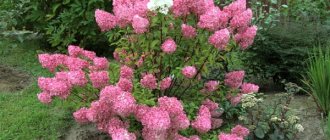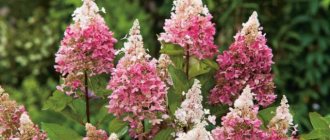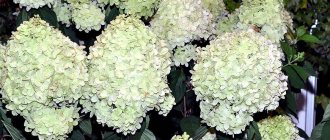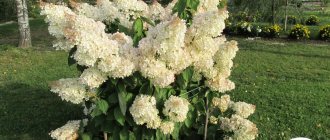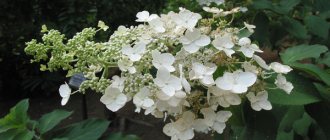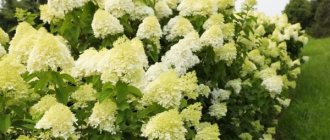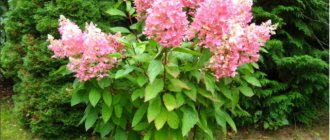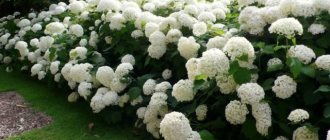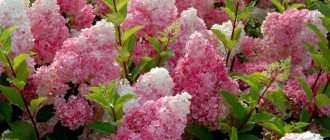To decorate their garden plots, gardeners choose the most spectacular plants. They should create beautiful single plantings or organic ensembles with various crops and shrubs. Preference is given to flowering specimens with well-developed branches and interesting shades of petals. One of the most beautiful varieties is Diamond Rouge hydrangea. This species is distinguished by its decorativeness and unpretentiousness, for which it has received high awards at international exhibitions.
Hydrangea Diamond Rouge is decorative and easy to care for
Description of hydrangea paniculata Diamond Rouge and characteristics
Hydrangea Diamond Rouge has strong shoots of a reddish-brown color, directed vertically upward. The bushes are spreading and can reach 1.2 m in diameter. Hydrangea leaves are elliptical or ovoid, with a pointed tip and small teeth along the edges, with clearly visible veins. On the shoots they are located opposite, covered with small villi. In the spring-summer period, the plates remain dark green in color, and in the fall they become orange or yellow with blurry red spots.
Attention! Hydrangea has a superficial branched root system that extends beyond the crown. When planting several bushes, you need to leave space between them.
The Diamond Rouge variety grows at an average speed. Hydrangea is not prone to aggressively taking over a site, so it can be placed next to other shrubs and herbaceous perennials. You just need to make sure that the plants do not take away moisture and nutrients from each other. The variety is resistant to unfavorable ecology and is well suited for cultivation in areas with polluted air.
Blooming Hydrangea Diamond Rouge
Hydrangea Diamond Rouge blooms on average from the first days of July; in the south it can bear flowers as early as the end of June. Produces large panicles 30-40 cm long in the shape of a cone with a wide base and a rounded top. In this case, the inflorescences do not seem massive, but retain an openwork structure, since large and small buds are distributed approximately equally in them.
The flowering of Diamond Rouge hydrangea largely depends on the conditions. With short pruning, the crop produces the largest and most lush panicles. With irregular watering and excess sun, as well as on unsuitable soil, the inflorescences will be smaller, only about 20 cm in length.
Diamond Rouge blooms for quite a long time and can remain attractive until October
The color of hydrangea changes several times during the season. At the very beginning of the decorative period, the inflorescences are white, after 2-3 weeks they begin to turn pink and, ultimately, acquire a deep crimson hue. For the rest of the time, the buds retain their rich color and shortly before drying out they become dark ruby.
Attention! For the first time, Diamond Rouge hydrangea blooms only in the third year of life. The formation of buds occurs on the shoots of the current season.
When growing hydrangea in a summer cottage, it is necessary to provide it with comfortable conditions and an annual haircut. Otherwise, Diamond Rouge will develop more slowly, and the inflorescences will become less spectacular, since they will remain modest in size and will no longer be able to dot the entire bush with huge lush caps.
Frost resistance of hydrangea paniculata variety Diamond Rouge
The winter hardiness of Diamond Rouge hydrangea is quite high. Even with minimal shelter, the variety can tolerate cold temperatures down to -30 °C.
The shrub is best suited for growing in the Moscow region and the middle zone. If you wish, you can also breed it in Siberia, but in this case you need to take care of the most reliable insulation.
Height of Diamond Rouge Hydrangea
Diamond Rouge is a medium-growing variety and reaches approximately 1.5 m above the ground. With regular pruning, it retains its compact outline, which makes it possible to grow the shrub, including in spacious tubs.
Shade tolerance of Diamond Rouge hydrangea
The variety is intended for planting in well-lit areas with light afternoon shading. It is not recommended to place the bush in bright sun. In this case, dark red panicles will fade under its rays, the duration of flowering will be shortened, and the decorative effect will noticeably decrease.
At the same time, it is also impossible to place shrubs in dense shade. With a lack of sunlight, Diamond Rouge will not be able to develop well and quickly. In the shade, the crop is less ventilated and more often suffers from waterlogging and fungal diseases.
Features of care
Let's find out what kind of care will ensure the successful functioning and long flowering of this magnificent ornamental shrub.
Watering
Since the root system of the plant is superficial, it cannot take moisture from deep layers of soil. Therefore, regular and sufficiently abundant watering is so important when growing a flower. Watering should begin in the spring, as soon as the buds begin to form, and end only before snow falls in the fall. Before wintering, it is recommended to moisten the plant especially abundantly: this will increase the frost resistance of its roots.
The average frequency of watering in normal weather is twice a week. If it is too dry and hot outside, watering is carried out after 2-3 days. And in damp, rainy weather, it is better to postpone the next moistening procedure in order to prevent the formation of a swamp in the flowerbed.
The water should be soft and not too cold. Pre-settle tap water, otherwise, due to its high chlorine and lime content, it will quickly make the soil alkaline.
Important: after watering, it is recommended to mulch the soil in the flowerbed. This technique will help keep the roots moist for a longer period.
Top dressing
In early spring, you need to feed the hydrangea with a complete complex fertilizer. During the period of bud formation, a second feeding is carried out using fertilizers with a low nitrogen content. In the fall, it is recommended to add potassium and phosphorus to better prepare the plant’s roots for the upcoming cold weather.
Trimming
Hydrangea Diamond Rouge is pruned annually. The procedure is carried out in the spring, choosing the time early, before the sap begins to flow. When pruning, you should shorten all shoots of the bush by about a third of the length, if the branches are damaged, then even more. Be sure to get rid of shoots that grow inside the crown and are frozen over the winter, weak, or rotten.
Keep in mind that flower buds are formed in this case on last year’s shoots and the current year’s. Therefore, you can painlessly and without consequences part with all shoots older than two years of age, and one-year-olds and shoots with new buds should be left as much as possible.
Note that the plant tolerates a haircut easily and quickly recovers after it, increasing its previous volume and splendor. On the contrary, after regular pruning the bush seems to come to life, becoming more beautiful and elegant. In addition, it already gets rid of many pests and diseases by removing old broken branches.
If high-quality shoots remain after pruning, they can easily be used for further rooting. This is exactly what most competent gardeners do. Note that semi-lignified hydrangea cuttings take root almost 100% after cutting.
Attention: if the main procedure is carried out in the fall, then in the spring only sanitary pruning is needed. But in the fall, it is recommended to shorten the shoots further - by two-thirds of the length.
Wintering
The plant has quite decent frost resistance, so wintering it does not pose any special problems. Without shelter, the shrub can survive even 29-degree frosts, but only if they are short-lived. If the climate in your area is more severe, it is still recommended to insulate the plant before winter.
If we are talking about hydrangeas of the first and second years of life, it is recommended to insulate them in any case. This does not require much work - you just need to cover the bush with spruce branches, sprinkle the root circle with bark, sawdust or dry straw.
Important: the frost resistance of the plant becomes higher with age.
We were introduced to a beautiful hydrangea called Diamond Rouge. This garden shrub pleases with its beauty throughout the summer, has high cold resistance, and is not too demanding to care for. Growing a flower is not difficult: by applying the simple recommendations from our article in practice, even an inexperienced gardener can cope with the task.
Advantages and disadvantages of paniculate hydrangea Diamond Rouge
Reviews of the paniculate hydrangea Diamond Rouge note the hardiness of the variety and its decorativeness. However, the bush has its disadvantages.
The Diamond Rouge variety rarely suffers from diseases and pests
Pros:
- compact outline;
- large paniculate inflorescences;
- high frost resistance;
- lends itself well to vegetative propagation;
- suitable for growing in containers;
- high resistance to diseases;
- The inflorescences are suitable for cutting and making dry bouquets.
Minuses:
- turns pale and often gets sick on alkaline soils;
- requires regular pruning;
- the inflorescences fade and quickly crumble in the bright sun.
Plant conditions
The plant is not picky about its conditions, however, some factors such as humidity, lighting and the quality of the soil layer must be taken into account.
Lighting
The Diamond Rouge variety requires a little darkening because it is difficult to withstand ultraviolet radiation. Therefore, under the influence of the sun's rays, you can observe the growth of the bush stopping and the inflorescences shredding. In the open sun, the foliage of the plant may get burned and the flowers may burn. The best place for planting is considered to be soil that is shaded by other plants. If this is not possible, temporary protection should be built in the form of a screen that will cover the hydrangea from the sun and strong side winds.
The protection should be constructed so that the plant is exposed to the sun during the daytime.
Temperature
The plant is very thermophilic, but can also be cultivated in cool climates. The normal temperature for development is considered to be 25 °C. When artificially protected from the sun, the plant is able to withstand elevated temperatures. The main condition is considered to be a moist soil layer around the trunk.
Humidity
To avoid competition, it is not advisable to plant hydrangea next to plants that love moisture. It is best to place the flower under the crown of ground cover varieties, for example, under saxifrage. Despite the fact that the plant loves moisture, it is not recommended to plant it near groundwater. Excess moisture will negatively affect the wintering of the plant and cause its death.
Soil and drainage
The variety loves clay and loamy soil layers. The plant does not grow in a sand-based substrate. This is explained by the fact that all the nutrients in the sand are washed out quite quickly, which can provoke their deficiency and starvation of the plant. The optimal place for the culture is considered to be a loose, organic-rich soil layer with a pH level within 5.5 units. The brightness of the inflorescences is beneficially affected by the acidic soil layer, which forces gardeners to add whey to the soil layer.
The favorable environment necessary for the normal growth of hydrangea can be created by the bacteria that are present in it. It is permissible to acidify the soil layer with peat, half-ripe pine needles and sawdust. They should be added to calcareous or alkaline soil, which will become suitable for normal cultivation and growth of the variety.
A plant growing in a neutral environment will not die, but the inflorescences will be quite pale and less attractive.
Watering
The hydrangea variety is considered a very moisture-loving plant that needs constant watering. The flower should be irrigated at least once every 7 days. In case of increased drought and high air temperatures, the plant will need to be watered 2 times more often. Depending on the type of soil layer and air humidity, in hot, dry weather the plant should be irrigated with water in a volume of 30 liters per 1 m2 of land. During the rainy season, watering should be carried out taking into account the humidity of the tree trunk. To nourish the root system of the crop, it is advisable to irrigate not under the trunk, but directly under the entire crown.
Reproduction methods
Most often, Diamond Rouge hydrangea is propagated by vegetative methods:
- Division. An overgrown bush 4-5 years old in early autumn is dug out of the ground and cut into 2-3 parts. Damaged and diseased roots are removed. The resulting seedlings are transferred to new holes; they must adapt to the soil before the cold weather.
- Cuttings. In June or early July, half-woody shoots with 2-3 internodes are cut from healthy bushes and the lower leaves are removed. The cuttings are rooted in water or a light substrate, and in the fall they are planted in the soil under reliable shelter or sent for storage in the basement.
- Layerings. One of the flexible lower shoots is buried in the ground, leaving the top on the surface, and watered regularly until the end of the season. In the spring, the rooted cuttings are separated and transferred to a new location.
Diamond Rouge seeds are practically not propagated, since the varietal characteristics of the resulting plants are not preserved.
Methods of growing and propagating plants
The variety can be propagated by cuttings, seeds or layering. Seed propagation is difficult and costly, and does not guarantee the preservation of maternal characteristics in the crop. Hydrangea seeds are susceptible to disease, germinate poorly, and the first flowering may occur only after 4 years. Propagation by cuttings is based on the use of shoots of the current year. Cuttings from last year's shoots will not take root well. Since the flower is protected, it is very difficult to purchase planting material.
Planting and caring for Hydrangea paniculata Diamond Rouge
Videos about Diamond Rouge hydrangea show that planting and caring for the shrub is not very difficult. At the same time, it is necessary to take a responsible approach to the choice of suitable timing and site for culture.
Conditions and terms of landing
Hydrangea Diamond Rouge is transferred to open ground in early spring. By the time of planting, the soil should warm up to 10 °C, and the air to 12-15 °C.
Attention! In the south, it is allowed to transfer the crop into the ground in the fall, about a month before the cold weather.
Panicle hydrangea should be placed in a well-lit area with light shade. The culture prefers loose soil with a neutral or slightly acidic reaction.
Planting Hydrangea paniculata Diamond Rouge
Planting Diamond Rouge hydrangea in the garden is carried out according to a simple algorithm:
- Dig a hole about 40 cm deep in the selected area.
- Prepare a nutrient substrate by mixing garden soil with red peat, humus and sand.
- Fill the hole halfway with soil.
- Place a seedling in the center and spread its roots to the sides.
- Fill the remaining voids with substrate and lightly compact the soil.
- Water the hydrangea with 20 liters of lukewarm water.
In the first week after planting, Diamond Rouge is recommended to be protected from bright sun.
Immediately after planting, the shrub is mulched with pine needles or straw - this prevents moisture evaporation and acidifies the soil.
Caring for Hydrangea paniculata Diamond Rouge
For good flowering, the shrub needs to be provided with quality care:
- Watering. The ornamental plant does not tolerate drought, so the soil at the roots should always be slightly moist. You can refuse watering only in rainy weather.
- Feeding. For good flowering, hydrangea is fertilized four times during the season. In the spring it is necessary to add nitrogen to the soil, when the buds are forming and at the moment the corollas open - complex mineral fertilizing. In autumn, the bush is supplied with potassium and phosphorus.
- Mulching. To slow down the evaporation of moisture, the soil at the roots is covered with pine litter or wood chips. The mulch layer additionally inhibits the growth of weeds.
Once every two weeks, it is recommended to spray the bush along the crown. After the buds open, irrigation is stopped, otherwise the decorative effect will decrease.
Advice! In order for the Diamond Rouge hydrangea to bloom as brightly as possible, it is recommended to add citric acid to the water for irrigation once a month at the rate of 15 ml per 10 liters of liquid.
Pruning hydrangea Diamond Rouge
Diamond Rouge bears buds on young shoots of the current year. Every spring it is necessary to cut the bush short into 3-4 internodes. During the procedure, thin, weak, diseased stems and branches that thicken the crown are also removed. At the end of the season, the shrub is freed from dried inflorescences.
Preparing for winter
In autumn, Diamond Rouge hydrangea is mulched in the root area with a layer of peat or dry soil of at least 20 cm. It is the underground part of the plant that needs to be protected from frost. Freezing of shoots does not affect the decorative appearance of the shrub, since inflorescences appear on annual branches.
Only seedlings under two years old require major shelter. It is recommended to bend them to the ground and cover them with spruce branches or tie them with white non-woven material along the crown.
Landing
In the process of growing paniculate hydrangea of the Brilliant Rouge variety, it is very important to carry out proper planting, since the further development of the plant depends on this. It is necessary to plant the crop in the right place so as not to provoke the development of diseases and pests .
It is important to choose a high-quality seedling, on the surface of which there will be no stains. Only after careful preparation of the planting material and place can you begin to plant the crop.
Video: Planting paniculate hydrangea
Landing dates
It is necessary to plant Diamond Rouge hydrangea in early spring . The optimal air temperature is at least +12°C, and the soil temperature is about +9°C.
If you live in the northern regions of the country, then it is better to postpone planting until the beginning of May . This will reduce the likelihood of the plant dying from low temperatures. Despite their high frost resistance, young bushes may become deformed and not strengthen.
Find out more about the features of planting hydrangeas in open ground.
Choosing a location and seedling
Paniculata hydrangea variety Diamond Rose needs a lot of light, so the crop should be planted in well-lit areas, on the south side of the garden . The bushes can readily develop in partial shade. If the hydrangea is constantly in the shade of buildings, barriers or other plants, then the inflorescences will be small, and the color saturation will also deteriorate.
When choosing planting material, consider the following features:
- absence of diseases (spots, plaque, etc.);
- age from one to two years;
- absence of mechanical damage (cracks, chips, etc.).
Soil preparation
Hydrangea variety Diamond Rouge prefers to grow on fertile loamy or clayey soils . The soil structure should be loose, but with sufficient nutrients. The soil must have a neutral pH - no more than 6 .
To increase soil acidity , if necessary, you can use whey (10 l per 1 m²). When the soil is ready, start digging the planting hole. The optimal dimensions are 70x70 cm.
We advise you to read what kind of soil is needed for planting garden hydrangea.
Landing instructions
The planting technology consists of the following steps:
- The day before planting, pour 20 liters of water into the hole.
- The next day, add 100 g of superphosphate and 100 g of nitroammophoska to the bottom.
- Pour a mixture of humus, peat and fertile soil into the hole (mix all components in equal proportions).
- Lower the seedling inside and sprinkle it.
- Compact the soil to prevent cavities from forming between the roots.
Diseases and pests
With quality care, Diamond Rouge rarely suffers from fungi. But sometimes she is affected by the following ailments:
- powdery mildew - a dry light coating appears on the leaves of the bush, and then dark spots appear;
Powdery mildew develops when the soil is waterlogged; the disease can be treated with a solution of copper sulfate - tracheomycosis wilt - pathogenic bacteria penetrate the plant tissue through the roots, the hydrangea begins to quickly wither.
To prevent tracheomycosis, Diamond Rouge hydrangea is treated with fungicides before planting.
Sometimes pests damage shrubs in open ground. Most often you can notice on the leaves:
- spider mite - the insect appears during a period of drought and entangles the shoots of bushes with a thin web;
Regular spraying of hydrangea helps get rid of spider mites. - slugs and snails - gastropods eat hydrangea leaves in rainy weather, especially when growing the crop in the shade.
To prevent slugs, the soil at the roots of hydrangea is mulched with rough material and sprinkled with wood ash.
In the fall, in the area with hydrangea, it is necessary to remove all plant debris and loosen the soil. Fungal pathogens and insects overwinter in fallen leaves and upper layers of soil.
How to grow a plant: step-by-step instructions
Hydrangea Diamond Rouge (photos and descriptions will tell gardeners how to grow the crop in open areas) is cultivated at the beginning of the spring season at an optimal air temperature of +12 °C and soil layer +9 °C. In the northern regions, it is recommended to postpone planting to the beginning of May. This is required to reduce the likelihood of the plant wilting as a result of exposure to low temperatures.
When choosing planting material, it is worth considering the following features:
- age from 1 to 2 years;
- absence of diseases, stains, plaque;
- absence of mechanical deformations such as cracks, chips.
You can grow a plant by observing the following points:
- A planting hole measuring 50x50x50 should be dug the day before, watering it thoroughly. After a day, you need to install the drainage layer and directly plant the plant.
- A 10-centimeter layer of gravel or broken brick is suitable for drainage.
- Then you will need to prepare a nutrient substrate. To do this, in a large container you need to mix 2 parts of humus with the same volume of leaf soil, 1 part peat and 1 part sand. Then you need to add potassium sulfate with urea (in a volume of 25 g) and superphosphate in an amount of 60 g.
- The mixed components in the form of a slide should be placed on top of the drainage layer and the seedling should be placed on it, straightening its roots. The remaining substrate should be sprinkled onto the root system so that the root collar remains above the surface of the soil layer.
- Then you will need to spill the hydrangea with water and wait until it is absorbed. Next, you will need to loosen the soil layer and mulch it using sawdust, rotted peat or pine needles.
- If you plant several crops, you will need to maintain a distance of approximately 50 cm between them.
Hydrangea Diamond Rouge in landscape design
Hydrangea Diamond Rouge is widely used when decorating a site. Most often, shrubs are planted:
Dense flowering bushes help to protect the area from prying eyes and can easily be formed into hedges;
Blooming red hydrangea looks bright against a background of evergreens next to conifers;- in group plantings with perennials.
Hydrangea Diamond Rouge serves as a vibrant focal point for artistic compositions
Diamond Rouge can be placed next to a fence or blank wall of the house. The bush will help decorate unoccupied space.
Disease Prevention
Hydrangea Diamond Rouge has good immunity and rarely gets sick or is affected by pests. Causes of problems:
- lack of microelements causes chlorosis;
- bushes fade in the active sun;
- in the deep shadow the colors become less bright;
- grow and bloom poorly when there is a deficiency of nutrients;
- the roots rot in the acidifying dense soil;
- hydrangea dries due to lack of moisture;
- the inflorescences become smaller in the absence of trimmings, if there is too much or not enough sunlight;
- aphids appear when an anthill is located nearby;
- Planting close to a walnut almost always causes sooty fungus.
Diamond Rouge is called the reddest variety of panicle hydrangea. Beginners can handle planting and care if they choose the right place and water the bush regularly. Large inflorescences can only be obtained with short pruning.
Reviews with photos about planting and caring for Hydrangea paniculata Diamond Rouge
Stepanova Irina Nikolaevna, 37 years old, Kazan
I really love Diamond Rouge hydrangea; I’ve been growing it on my property for five years now. I like how the shrub changes color when flowering - at first the panicles are bright white, then gradually turn pink and turn red. Maintenance is generally simple, the main thing is to water and acidify the soil on time.
Anisimova Tatyana Aleksandrovna, 43 years old, Vladimir
Hydrangea Diamond Rouge was first planted in the country three years ago. Last season I admired the flowering for the first time; the panicles were indeed very bright, dark, and lush. The shrub is not capricious and tolerates winter well.
Growing conditions
We will find out how to choose a place in the garden for this hydrangea, what conditions the plant needs for a prosperous existence and elegant flowering.
Location and lighting
This hydrangea is light-loving, but will not disappear in partial shade. However, full shadow does not suit her at all. Select a site so that the bush is protected from direct sun at midday. The fact is that when grown in the sun, the decorative qualities of the plant are significantly reduced.
Temperature
The plant will feel best at moderate temperatures. Hydrangea Diamond Rouge can hardly tolerate drought; severe frosts are also destructive for it.
Humidity
Like all hydrangeas, Diamant Rouge is also quite moisture-loving. It is recommended to plant it at a distance from other plants that value moisture, so that there is no competition for resources, and so that the shrub does not lose its attractiveness.
Watering will have to be done frequently and abundantly - on a regular basis. It is recommended to mulch the soil without fail so that the roots remain moisturized longer.
Priming
The plant will develop normally and be in excellent health in fertile, clay-rich soil. The best option is loam. Sandy soil is absolutely not suitable in this case - it will not retain the moisture necessary for the plant. Acidity is also important - it should be either weak or neutral, but not alkaline.
We found out what kind of plant the Diamond Rouge hydrangea is. As you can see, the flower has a completely unpretentious character and a magnificent appearance. By planting this hydrangea on your site, you will get a magnificently flowering plant that will delight you with its beauty all summer long.
Description of flowering
The height of the hydrangea bush is about 1.5 meters. Its crown consists of inflorescences that have a characteristic shape resembling pyramids (panicles). In addition, this variety is distinguished by large panicles, which reach thirty centimeters in width and about forty centimeters in length. Hydangea paniculata diamond rouge blooms for four months, starting from June and ending in October (until the first frost). It is noteworthy that during the flowering period the shrub changes its color several times.
At the first stages, its inflorescences are snow-white, after one and a half to two weeks they begin to turn pink, then red, and by the end of flowering the bush acquires a rich burgundy color. The foliage is not inferior to panicles in decorativeness. At the beginning of spring it is bright green, over time it becomes dark green, then purple, even orange. The leaves are oblong in shape with a velvety surface.
The root system of Diamond Rouge is superficial. The roots are several times wider in diameter than the crown. This plant prefers cool and partial shade to direct sunlight, and also grows and develops normally in the shade. If the shrub is planted in an area in direct sunlight, the inflorescences gradually become smaller. Being a moisture-loving plant, the plant does not tolerate drought quite well. In connection with this circumstance, it is recommended to mulch the tree trunk annually to retain moisture in the soil and maintain its fertility, which, of course, has a beneficial effect on the plant during the flowering period.
Description of the variety
The Diamond Rouge variety was obtained through the efforts of specialists from the French nursery Pepinieres Renault, specializing in the selection of new varieties of hydrangeas. This happened at the dawn of this century, and since then the plant has been a constant participant in various exhibitions and competitions, where it takes high places and receives medals for its excellent varietal qualities. The highest achievement of “Diamond Rouge” can be considered the silver award of the world flower exhibition “Plantarium 2011”, held in the Dutch Boskop, where the hydrangea was noted by the jury as the best flower with red buds.
Hydrangea "Diamond Rouge" is a compact tree-like bush 1.5 m high with a crown diameter of up to 1.4 m. The plant has a branched root system, located at a shallow depth, and straight shoots, painted in brown-red tones. The oppositely arranged oblong leaves are quite dense, covered with sparse hair and pointed at the ends.
The inflorescences of "Diamond Rouge" have a pyramidal shape and grow up to 30 cm. Flowering lasts from mid-June to the end of September, however, it may shift slightly depending on conditions. A special feature of this variety is the continuous change of flower color throughout the season. Thus, by the end of flowering, the blossoming snow-white buds acquire bright red shades, changing the appearance of the June plant beyond recognition.
However, not only the flowers change their color: the leaves of Diamond Rouge also change in color, and if in June they are bright green, then by September they turn orange. The formation of inflorescences occurs on the branches of the current year, and the young plant begins to bloom only in the third year. Hydrangea "Diamond Rouge" has an average growth rate, so there is no rapid growth and takeover of surrounding areas, and the flower grows quietly next to other species.
Description of the plant
The garden hydrangea variety Diamond Rouge is a tree-like bush with lush inflorescences, the height of which is 1.8 meters. It differs from other varieties in the shape of its inflorescences, which resemble pyramids more than 30 centimeters long. Flowering period - from June to mid-autumn.
The color of the flowers changes throughout the entire period - from white to dark red. Climatic conditions and soil composition can also affect color. The plant produces its first flowers only in the third year of life.
The slightly velvety foliage of Diamant Rouge is oblong in shape. Just like the flowers, the leaves change color during the flowering period from deep green to orange.
Reproduction
Hydrangea paniculata is best propagated by green cuttings and layering. Cuttings are harvested from the current year's shoots in June, when buds have already appeared on the bush.
Cuttings taken in the fall from woody shoots take root much worse.
The shoot segment should have 3 pairs of buds. The lowest bud of the cutting is left 2 centimeters above the cut. The cut is made obliquely. The lower leaves are removed, the rest are partially cut off to prevent moisture evaporation.
The cuttings are treated with a solution that stimulates root formation. Then they are planted two-thirds of the way into pots under jars or a greenhouse under film in fertile soil with a top layer of sand.
There are two ways to plant rooted cuttings in open ground:
- Plant the plant in August in the “school” and protect it from freezing with covering material. It is advisable that seedlings in the “school” beds gain strength for 2 years. The emerging flowers must be cut off. In spring, the strengthened plant is planted in a permanent place.
- Leave the pot with the plant to overwinter in a cool room until spring planting.
Propagation of paniculata hydrangea by lignified cuttings in autumn:
When propagating a shrub by layering, the flexible young shoot is bent down, pinned and covered with earth.
The surrounding soil is kept moist and loose. The next year the plant can be separated from the mother bush.
Hydrangea paniculata Diamond Rouge looks great both as a tapeworm and in an ensemble with other garden plants.
Thanks to its easy care, excellent coloring and luxurious flowering, this ornamental shrub will become a source of pride even for a novice gardener.
Reproduction of the variety
Diamond Rouge hydrangea can be propagated by seeds, cuttings and layering.
Hydrangea bush can be propagated in three ways
The first method gives too little chance of getting healthy bushes and takes a very long period of time (from 4 years).
The second option is more effective. For cuttings, use this year's shoots in June; last year's will take root worse. Cut off a shoot with three or more eyes, leaving 2 cm at the bottom, and remove the leaves from above. Place the cuttings in water for several days, adding a growth stimulator to it.
The next stage is to place the cuttings in a container with soil made of peat and sand in a ratio of 2:1. They are buried 2/3, sand is poured on top. Cover the cuttings with glass or film and water every day. After 21 days, the first roots will appear. Containers can be removed, and watering does not stop. In winter, it is worth moving them to a cool place, but without sub-zero temperatures. They are transplanted to a permanent place a year later in August.
Note! If buds appear on rooted cuttings, they need to be cut off to allow the plants to grow stronger. To propagate by layering, dig a ditch next to the main bush, bend the lower shoots on which several cuts need to be made, and fix them with something heavy to the ground.
The furrow is filled with soil from above and watered. By next spring you can expect new shoots, but their transplantation is possible only after a year
To propagate by layering, dig a groove next to the main bush, bend down the lower shoots, on which several cuts must be made, and fix them with something heavy to the ground. The furrow is filled with soil from above and watered. New shoots can be expected by next spring, but transplanting them is possible only after a year.
Hydrangea Pink Diamond winter hardiness
The shrub tolerates cold well, of course, unless we are talking about the northern regions. The colder it is where it grows in winter, the more likely it is that it will need to be covered for the winter.
When preserving Pink Diamond in winter, it is worth remembering that it is very important to preserve last year’s shoots, because the main flowers will appear on them. When constructing a shelter, branches should be bent to the ground
If we are talking about an adult plant, then it does not require intensive shelter, but if it is a young plant, then it is better to first cover it with foliage. Early shoots may be frostbitten, but there is nothing terrible here, they recede very quickly. Hydrangea is planted both in a single composition and in a group. Do not forget that in the process of its development, it will be more than half a meter wide, and this fact should be taken into account when planning the composition of the garden, and especially the flower bed.
Varietal characteristics
There are several types of hydrangeas. They differ from each other in the type of trunk, the shape and size of the leaves, and the shape of the inflorescences. The paniculate variety most attracts breeders. The name of this species was given by the elongated shape of the inflorescences. Each “panicle” collects small, sterile flowers.
Breeders have developed many varieties of hydrangea. Anyone who likes bright flowers will love the Diamond Rouge variety. As the name suggests, the flowers of this plant are bright pink. In resort villages, hydrangeas of the described variety are often grown for bouquets.
A perennial shrub does not require complex care. The main thing is to choose a good place for the plant, and then water and fertilize the bush in time. The plant will bloom 3-4 years after you plant it. With proper care, hydrangea can live 25 years. The plant will bloom at any age.
Appearance
If you have not decided which ornamental crop you want to plant, pay attention to the described variety. Description of paniculate hydrangea Diamond Rouge:
- spreading bush reaches 1.2–1.5 m in height;
- the bush has a wide crown (1.2–1.3 m);
- the roots of the plant go shallow into the ground, however, the root system occupies an area equal in diameter to its crown;
- the plant has strong, straight shoots;
- the branches of the bush are colored brown;
- oblong leaves are located opposite;
- the leaf has a velvety surface, its average length is 11 cm;
- in summer the leaf blade is painted in a rich green tint, by October the color of the leaves of the bush becomes bright orange;
- The spectacular bush blooms for about 100 days - from late June to October.
Hydrangea Diamond is a deciduous shrub. Luxurious inflorescences appear on this year's shoots. Each inflorescence has the shape of a pyramid. The length of the “pyramid” is 27–39 cm. No matter how beautiful and durable the plant is, you are primarily interested in the shade of its flowers.
At the beginning of flowering, you will see white inflorescences on the decorative crop. After 2–3 weeks, the flowers acquire a bright pink hue. At the end of summer the inflorescences turn purple-red.
Before purchasing seedlings, read the description of the crop and see what it looks like. The ornamental plant often develops in the form of a spreading bush. Occasionally you can see a tree with two or three trunks and many shoots.
At the beginning of spring, the shrub will attract your attention with the beauty of its branches and the richness of its leaves. In summer, pyramidal-shaped inflorescences appear on the shoots
The bright color of the “pyramids” makes paniculate hydrangea Diamond Rouge the most recognizable among related crops.
An interesting detail: the shade of the inflorescences can change depending on the composition of the soil. The color of the “panicle” is affected by weather conditions. In rainy summers, Diamond hydrangea will surprise you with purple flowers, and in dry weather its inflorescences turn crimson.
In autumn, the bushes do not lose their spectacular appearance. The elongated leaves of the plant change color from green to orange.
Frost resistance
Not all varieties of ornamental crops can grow in the middle climatic zone. Some varieties of hydrangeas are too heat-loving. Hybrid Diamond Rouge compares favorably with other representatives of the Hydrangeaceae family. An adult plant of this variety can tolerate frosts down to –33 °C.
Watch this video on YouTube
Thanks to the frost resistance of the shrub, it can be planted in the central regions of our country. In harsh winters, hydrangeas may lose some of their shoots, but in the summer the plant will recover. With proper feeding, Diamond hydrangea can quickly increase the required volume of green mass.
The plant has many advantages. It is often grown to decorate areas. Disadvantages of ornamental crops: inability to tolerate drought, demanding soil composition.
Feeding is the key to good hydrangea flowering
Regular feeding also influences favorable development:
- As a fertilizer at the first stage of plant development, it is allowed to use diluted nettle tincture (one liter per bucket of water).
- Also suitable organic products are bird droppings and manure, which are also diluted in water so as not to burn the plant.
- Mineral supplements should be treated with caution. They are dissolved in water for irrigation in a certain ratio, which is indicated in the instructions. Such fertilizing is carried out once every ten days, fifteen is allowed, but no more.
The hydrangea paniculata shrub requires annual rejuvenation. The pruning procedure is carried out in the fall. A pruning shear (with a fairly sharp blade) is used to cut off fallen flowers, old, weak branches, as well as those that grow inside the bush. It is advisable to leave no more than ten strong branches for the winter.
This is necessary to ensure that the branches do not break off during heavy snowfall or freezing rain. In spring, the pruning procedure is carried out before the sap flow begins. The branches of a bush that is not very old are cut off by 2–3 buds, and of a young one by 3–5. These manipulations allow the plant to grow stronger over the summer.
